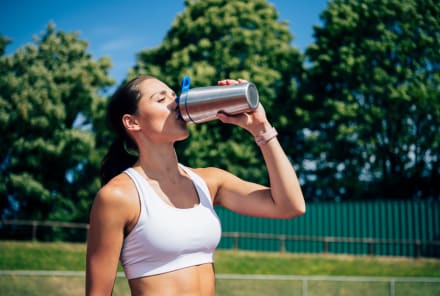Advertisement
Is It Long COVID Or Low Iron? New Study Says It Could Be Both

Hannah Frye is the Assistant Beauty Editor at mindbodygreen. She has a B.S. in journalism and a minor in women’s, gender, and queer studies from California Polytechnic State University, San Luis Obispo. Hannah has written across lifestyle sections including health, wellness, sustainability, personal development, and more.

Years after the discovery of the COVID-19 virus, many people still wonder whether their current symptoms can be traced back to the illness they contracted one, two, or even years ago. Up to 65 million people worldwide have contracted long COVID1, according to one estimate, and more than 200 symptoms of long COVID have been identified—from brain fog to difficulty breathing. There is still a lot we need to learn about long COVID, but a new finding just shed light on one potential trigger.
Long COVID may be connected to dysregulated iron levels
A new study published in the journal Nature Immunology found that iron dysregulation may be a trigger for long COVID2.
To reach these findings, researchers monitored 214 adults who tested positive for coronavirus (SARS-CoV-2). They tracked patients' symptoms and took their blood samples for one year after that initial positive test to try to tease out patterns of long COVID.
Of the 214 people monitored, 45% went on to exhibit some long COVID symptoms. Researchers observed that many of these people had low iron levels in their blood as early as two weeks post-COVID.
The research team categorized participants into five groups based on initial COVID symptom severity: asymptomatic, mildly symptomatic, moderate without supplemental oxygen requirement, moderate with supplemental oxygen requirement, and severe with assisted ventilation.
Participants in the first two groups, who did not require hospitalization, showed lower levels of inflammation in the body and less disruption in iron levels post-COVID (so while iron levels may be a point of concern for severe COVID cases, they're not something that everyone needs to worry about).
The individuals in groups three to five, however, were more likely to report long COVID symptoms. They were also more likely to have inflammation and low iron levels months later.
Now, this isn't entirely surprising given that heightened inflammation can lead to low iron levels3 (iron-deficiency anemia). "Inflammatory anemia4" is known to present in patients with diseases that cause prolonged immune activation. It can cause symptoms including fatigue, cardiovascular trouble, impaired learning, hindered exercise performance, and memory concerns—many symptoms that are shared with long COVID.
"Iron plays an integral role in making DNA, supporting energy production, and (most notably) shuttling oxygen around cells and tissues. Not having enough iron leads to nondescript symptoms like fatigue and lightheadedness," registered dietitian and mindbodygreen's supplements editor Molly Knudsen, M.S., RDN, previously shared.
In this new study, the same participants with low iron levels post-COVID also had increased levels of iron storage protein ferritin, which stayed high for almost 200 days after the onset of the disease, continuing to cause inflammation.
This evidence suggests that iron may be associated with long COVID, especially for severe cases. This offers a possible focus area for preventing long COVID symptoms by addressing iron at the initial disease onset. These findings also offer physicians another potential way to help patients who have partially, but maybe not fully, recovered from a severe case of COVID in the past few years.
While you can't undo the onset of COVID, you can help to address anemia in the body.
Those who already struggle with iron deficiency might want to make iron supplementation an even bigger priority and consider additional testing during their weeks post-COVID. However, if you think you're experiencing long COVID, it's best to get your blood tested with a physician before considering supplementation.
The takeaway
A new study found that individuals with long COVID symptoms exhibited low iron levels, which could persist for months post-recovery, potentially exacerbating inflammation and related symptoms. This is yet another reason to stay on top of iron levels—particularly for those who are recovering from illness or who have struggled with deficiency in the past. Here's a list of 64 iron-rich foods and a handful of iron-containing supplements to help keep your levels up.
Watch Next
Enjoy some of our favorite clips from classes
Enjoy some of our favorite clips from classes
What Is Meditation?
Mindfulness/Spirituality | Light Watkins
Box Breathing
Mindfulness/Spirituality | Gwen Dittmar
What Breathwork Can Address
Mindfulness/Spirituality | Gwen Dittmar
The 8 Limbs of Yoga - What is Asana?
Yoga | Caley Alyssa
Two Standing Postures to Open Up Tight Hips
Yoga | Caley Alyssa
How Plants Can Optimize Athletic Performance
Nutrition | Rich Roll
What to Eat Before a Workout
Nutrition | Rich Roll
How Ayurveda Helps Us Navigate Modern Life
Nutrition | Sahara Rose
Messages About Love & Relationships
Love & Relationships | Esther Perel
Love Languages
Love & Relationships | Esther Perel
What Is Meditation?
Box Breathing
What Breathwork Can Address
The 8 Limbs of Yoga - What is Asana?
Two Standing Postures to Open Up Tight Hips
How Plants Can Optimize Athletic Performance
What to Eat Before a Workout
How Ayurveda Helps Us Navigate Modern Life
Messages About Love & Relationships
Love Languages
Advertisement

This Type Of Fat Is Vital For Women's Health — Are You Getting Enough?
Molly Knudsen, M.S., RDN

New Study Confirms The 3 Habits That Age Your Brain Faster
Molly Knudsen, M.S., RDN

This Type Of Fat Is Vital For Women's Health — Are You Getting Enough?
Molly Knudsen, M.S., RDN

New Study Confirms The 3 Habits That Age Your Brain Faster
Molly Knudsen, M.S., RDN













